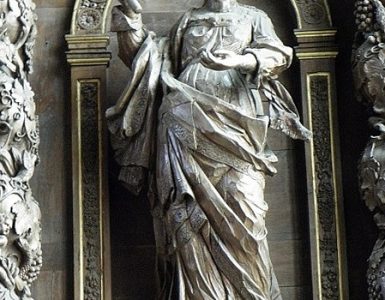Death is swallowed up in victory. These words of St. Paul to the Corinthians sum up in a certain way the life of the Blessed Virgin Mary. She contended with the Angel of Death at various junctures, as signaled by her confrontation with the dragon in the Book of Revelation. But the Assumption demonstrates that victory eclipsed death so greatly in her life that God would not even allow her earthly body to experience the corruption of death. Indeed, victory over death is at the core of the celebration of the Assumption of the Blessed Virgin Mary. A victory that came at the end of a most challenging but most graced life journey.
Lest we commit the mistake of celebrating her Assumption in isolation from the rest of her life, I would like to reflect on those major life events that brought Mary eventually to the kind of pinnacle that is the Assumption. A kind of crown won by many victories throughout her life thanks to her enduring faith in God’s providence.
Pope Pius XII & the Dogma of the Assumption
Almost seventy years ago, Pope Pius XII proclaimed the Dogma of the Assumption, which declares that the Virgin Mary was assumed body and soul into heaven, her body uncorrupted by the decay of death. Pope Pius also said that the Assumption was “a truth that has been revealed by God” (Munificentissimus Deus, 12). It was the truth that Mary “had actually passed from this life” and that “her sacred body had never been subject to the corruption of the tomb” (Ibid., 14). He also referred in a beautiful way to Mary’s body. He called it the “august tabernacle of the Divine Word” (Ibid.). August meaning majestic. He also said it “had never been reduced to dust and ashes” (Ibid.) Isn’t that a beautiful image? Her body was and remains a majestic tabernacle that God never allowed to be reduced to dust and ashes. A majestic tabernacle that, when the time was right, God assumed into the celestial Jerusalem.
Pope Pius XII said something else very important that reminds us not to celebrate the Assumption in isolation. He said that the truth of Mary’s Assumption had “shone forth in new radiance” (Ibid.,4) since his predecessor Pope Pius IX had proclaimed earlier the Dogma of the Immaculate Conception.
The Immaculate Conception, of course, refers to Mary’s privilege of being preserved from the stain of original sin at the time of her conception in the womb of her mother St. Anne. Let’s consider this for a moment. Why would he say that? Why would he say that Mary’s Immaculate Conception would make Mary’s Assumption shine forth with a new radiance? He said these two privileges were most closely bound with each other. That’s something really worth meditating.
Mary’s Life as a Waterfall
I would propose a metaphor to help us. Imagine the Virgin Mary’s life as a pristine waterfall, with two pristine bodies of water at the top and bottom. The source of water at the top is the Immaculate Conception. The waterfall represents Mary’s incredible life of faith. At the bottom of the waterfall is the receiving pool of water that is the Assumption. I propose that image because if we imagine the water as God’s grace, we get an idea of just how immersed in grace her earthly life was.
At the outset, God did not allow original sin to touch her as she was conceived in absolute purity. And floating and falling along the pristine waters of her life, arriving at the other body of pristine water, God was not going to allow the sting of death to touch her. Our Blessed Mother was most gracefully conceived in victory and most gracefully assumed into Heaven in victory. I invite you to think of the Immaculate Conception and the Assumption as the two victorious bookends of her earthly life.
Now, perhaps the analogy breaks down just a little when we contemplate all the challenges of her life. It was not a smooth, graceful drop into the receiving pool of water. It was more like one of those waterfalls that meanders its way down a rocky, jagged cliff face. Mary experienced many, many crosses in her life. Pope Pius XII also addressed this when he proclaimed the Dogma of the Assumption. He said that she “led a life troubled by cares, hardships, and sorrows, and that, moreover, what the holy old man Simeon had foretold actually came to pass, that is, that a terribly sharp sword pierced her heart as she stood under the cross of her divine Son, our Redeemer” (Ibid.,14).
Hardships, Joy, & Faith
Yet we find something else mixed in with the hardships; joy and faith. Joy and faith during the Annunciation, after Mary overcomes her shock at the revelation of God’s plan including her as mother of the Savior. Joy and faith in the form of a baby leaping for joy in Elizabeth’s womb during the Visitation. Joy and faith confirmed in Mary’s response to Elizabeth: My soul proclaims the greatness of the Lord! My spirit rejoices in God my Savior for he has looked with favor on his lowly servant!
We find more hardship mixed with joy later on during the entrance of the Savior into the world, born poor among animals in a manger. Hardship during the flight to Egypt and what must have been a difficult stay until it was finally safe to return. How about the hardship years later of watching Jesus the man depart her home to begin his public mission to the masses?
Yes, joy as Mary witnesses Jesus working miracles and preaching the Good News. But hardship in watching him suffer cruel persecution as a result. A persecution that culminates in the hardship of hardships when Simeon’s prophecy is fulfilled; her heart is pierced with the sword of deepest grief and agony at the foot of the Cross as she witnesses Jesus consummate his sacrifice as the Lamb of God. And let us not forget that after the ecstasy of witnessing his resurrection and glorified body, there were surely years of additional hardship passed in his absence after his Ascension: years of solitude, embattled faith, and the martyrdom of memories.
So many joys, sorrows and hardships. All worth contemplating on the Feast of the Assumption, which should be pondered within the context of an entire life awash in grace and faith. Let us pray as we honor that life:
Prayer to the Virgin Mary
Blessed are you, Virgin Mary, for your Immaculate Conception.
Blessed are you for reverencing God from your earliest years.
Blessed are you for meditating on the Scriptures and praying for the coming of the Messiah.
Blessed are you for believing the Archangel Gabriel sent to share with you God’s plan of salvation for the world.
Blessed are you for how you loved and cared for Jesus while raising him.
Blessed are you in trusting in God’s providence as you gave him up to his mission.
Blessed are you for your faith and courage during his Passion, graceful even in allowing your heart to be pierced by the sword of sorrow.
Blessed are you for your years of solitude after he ascended to Heaven, for your assent in receiving him only in spirit and in the Holy Eucharist.
Blessed are you for the way you lived your entire earthly life, Virgin Mary.
Blessed are you for being taken up body and soul into Heaven, your body uncorrupted by the curse of Eve.
Blessed are you, Virgin Mary, for being crowned Queen of Heaven and Earth.
Blessed are you for assisting us to this day from Heaven, for appearing to us so many times and teaching us by word and example, for encouraging us and consoling us as we grapple with our crosses.
Blessed are you, Virgin Mother, for accompanying us today at this altar, where we will receive the body and blood of your Son in this most holy sacrament.
Inspire us to live as you did, a life full of courage and reliance on the Lord. Continue to pray for us as our Advocate in Heaven, until that day when our bodies might also be glorified, our souls joined with yours in glorifying God, our souls, like yours, finally beholding the face of your Son in Heaven. Amen.
✠
image: The Assumption of the Virgin by Master of James IV of Scotland (Flemish, before 1465 – about 1541) / Wikimedia Commons












